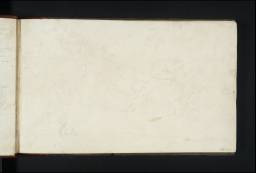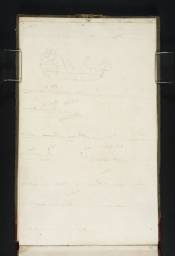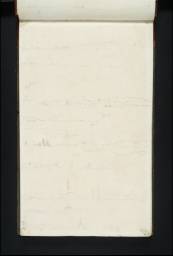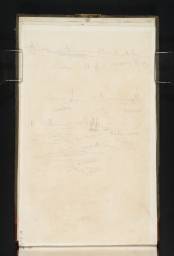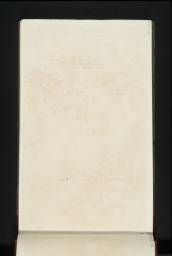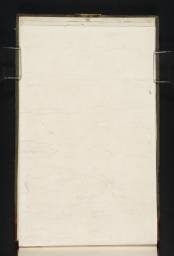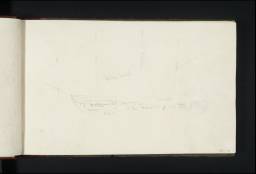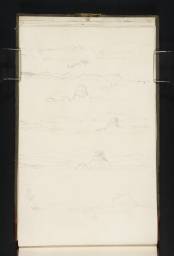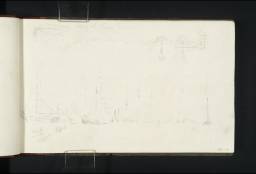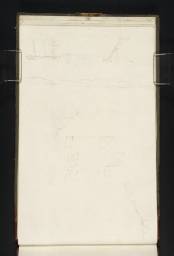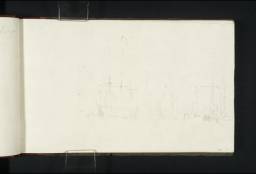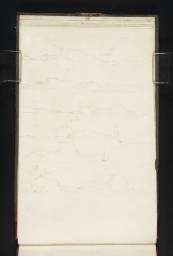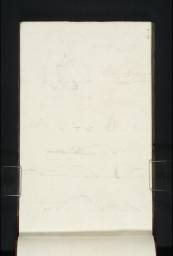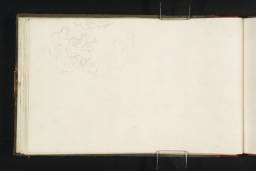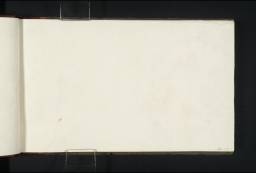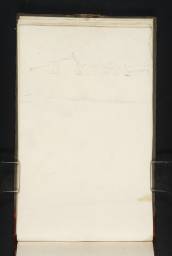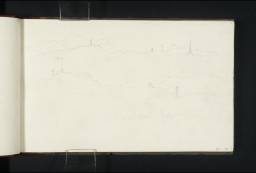Turner Bequest CC
Post Octavo notebook, bound in blue-grey paper-covered boards with a brown leather spine and a broken brass clasp; outside front cover inscribed in blue pencil ‘S62’ centre, and stamped in black ‘CC’ top right; Executors’ endorsement on the inside front cover (D40687)
91 leaves of white wove paper watermarked ‘ALLEE | 1819’
Approximate paper size 114 x 187 mm
Perhaps made at the Eyehorne Mill or Park Mill, Hollingbourne, Kent
91 leaves of white wove paper watermarked ‘ALLEE | 1819’
Approximate paper size 114 x 187 mm
Perhaps made at the Eyehorne Mill or Park Mill, Hollingbourne, Kent
Accepted by the nation as part of the Turner Bequest 1856
Exhibition history
References
The King’s Visit to Edinburgh seems to have been the only sketchbook that Turner took with him to Scotland in 1822, although a second sketchbook is associated with this tour (King at Edinburgh sketchbook: Tate D17672–D17718; D40978–D40980; Turner Bequest CCI) as he used it to work on several compositions based on the sketches he had made in the present book.
The purpose of Turner’s trip was to witness the official visit of King George IV to Scotland: an important occasion for the public image of the new King, and an historic event for the relationship between Scotland and England that was stage-managed to a large extent by Sir Walter Scott, the man that had brought Turner to Scotland in 1818 and may have encouraged his visit on this occasion.
Just over seventy per cent of the pages in the book contain sketches of or closely related to the official events and ceremonies of the royal visit. Over twenty per cent are of east-coast subjects. The rest of the pages were drawn on prior to the visit. Turner seems to have casually employed this sketchbook – starting at what is now considered the back of the book – for sketches of rural stretches of the Thames and to develop ideas for an oil painting based on a Claudian prototype and sketches made in France in 1821 (folios 88 verso–89; D17665–D17666). When he needed a sketchbook to take to Scotland he took this then nearly empty book, turning it over and beginning from the other side. As he began to run out of room at the end of the book the subjects became muddled up and even overlaid.
For speed and convenience he travelled to Scotland by sea. Taking the opportunity to sketch over 450 miles of coastline Turner made around twenty-five pages of sketches (folios 1 verso–5, 7 verso–8, 78–80, 81–84, 86, 87, 88, 91; D17509–D17516, D17521–D17522, D17644–D17648, D17650–D17656, D17660, D17662, D17664, D17670), with five to eight sketches per page. These were made for general interest but with a notion of future usefulness. Several sketches contributed towards the ongoing print project, The Provincial Antiquities and Picturesque Scenery of Scotland (see folios 78 verso and 79 of this sketchbook; D17645, D17646) and Tour of Scotland 1818 Tour Introduction). Turner also made two vignette designs for the two frontispieces of the 1826 two-volume edition of the series based on events of the royal visit (Tate D13748, D13749; Turner Bequest CLXVIII A, B).
Turner’s record of the royal visit began with the sighting of the royal squadron as it approached Leith Roads on 14 August 1822. Over a quarter of the book’s pages are given over to shipping subjects, most of which were made from the water on 14 and 15 August. Studies concentrate on the King’s yacht, the Royal George (folio 4; D17514), and other boats of the squadron, as well as general shipping studies. Turner also paid attention to the harbour of Leith (folio 53 verso; D17598), and the view of Edinburgh in the distance (folio 11; D17528).
Three events of significance are associated with Leith in Turner’s drawing: Sir Walter Scott’s visit to the King’s yacht on the afternoon of 14 August (folio 62; D17615), George IV’s departure from his yacht on the 15th (folio 5 verso; D17517), and his disembarkation at Leith Harbour (folio 58 verso; D17608). Turner worked on all of these subjects back in the studio, making oil sketches of the first two (The Mission of Sir Walter Scott, circa 1822, Tate N02879 and The King’s Departure from the Royal George, circa 1822, Tate N02880),1 and a pencil study of the third (Tate D17767; Turner Bequest CCII J). Scott’s visit to the royal yacht also became the subject of the frontispiece vignette of volume two of the 1826 edition of the Provincial Antiquities (Tate D13749; Turner Bequest CLXVIII B).
There are also sketches of two or three other events on 15 August, though perhaps not all made on that day. Turner did not actually sketch the King’s procession to the city of Edinburgh, but he did make studies of the route (folios 39 verso and 40; D17571, D17572). A view of Edinburgh from Arthur’s Seat has also been connected with the procession,2 although other possible occasions have also been suggested (see folio 41; D17574). Finally, Finley has proposed that a tiny and unique study on folio 36 (D17564) may relate to the ceremony with the Regalia at the Palace of Holyrood which took place shortly after the King’s arrival. This interpretation is also questionable.
Other events of the royal visit that Turner sketched were the procession to Edinburgh Castle with the Regalia of Scotland on 22 August that Turner drew from street level (folio 35 verso; D17563) and from the ramparts of the castle (folio 36 verso; D17565) the Peers’ Ball at the Assembly Rooms on 23 August (folio 47; D17585) the interior of St Giles’s Cathedral in connection to the King’s attendance on the 25th (folio 33 verso; D17559); the laying of the foundation stone of the National Monument (folio 22 verso; D17540); and a sketch of Hopetoun House in connection to the knighting of Henry Raeburn (folio 45 verso; D17582).
All of these subjects except Hopetoun House were incorporated into a series of nineteen compositional studies made in the King at Edinburgh sketchbook (Tate D40979, D40980; Turner Bequest CCI 43a, Inside back cover) which Gerald Finley suggests is Turner’s plan for a ‘Royal Progress’ cycle of paintings.3 The series also includes subjects that were not sketched on the spot by Turner; some of these events he witnessed and drew from memory, others he may not have seen but imagined or relied on other artists’ depictions and written accounts. In addition to The Mission of Sir Walter Scott and The King’s Departure from the Royal George, two further unfinished oil paintings resulted from this series: George IV at St Giles, Edinburgh, circa 1822 (Tate N02857),4 and George IV at the Provost’s Banquet, circa 1822 (Tate N02858).5 As well as the designs for the Provincial Antiquities vignettes, another watercolour design resulted from sketches made on the trip; this was based on the procession to Calton Hill for the foundation stone ceremony and was engraved for Fisher’s Illustrations to the Waverly Novels of Sir Walter Scott called March of the Highlanders, circa 1836 (Tate N04953).
Turner made sketches of the coast during his journeys to and from Leith (see folios 1 verso and 78 verso; D17509, D17645). Unlike the sketches of the royal visit his approach here is generally formulaic. The sketches record the coast from Suffolk to Leith, and there are a few studies of the sky and the weather which are concerned with effect rather than topography (see folio 3; D17512). John Ruskin removed three leaves from this sketchbook – folios 2, 3 and 88 (D17510–D17511, D15712–D17513, D178664–D17665) – to include in the Turner displays at Marlborough House and subsequent venues as ‘good examples of his mode of studying skies’ and as an ‘example of sketches of coast and shipping’.6 These apparently interested him more than any of the Edinburgh studies.
Turner’s sketching style in this book is varied, but can always be related to his particular concern with a subject. Sometimes his attitude towards a subject is reflected in a sketch, but more often it is the sketch, or a group of sketches, that reveal his attitude towards a subject. Turner’s approach to the east coast was remarkably consistent, revealing that it was his aim to create a kind of sketched map of the route by making scores of similarly sized and styled sketches of the coastline. The only variation is a result, as John Ruskin noted, of ‘the accidental variations of distance between the vessel and the land’.7 Certain parts of the coast were obviously of more interest to him than others, and some parts are notably neglected (he could hardly have sketched non-stop for the ninety-hour journey), but a number of drawings of undistinguished stretches suggest that his concern was to map as much of the coast as possible. Holding the sketchbook in the portrait format allowed him to make about half a dozen small panoramic sketches across the page, usually from top to bottom. Most are just a centimetre or so high and use the full width of the page. They vary in detail from just a few undulating lines to more precise studies of cliffs, hills and architecture, and some are labelled with the location. The exception in terms of style is the East Lothian subjects: most tend to be slightly larger and more detailed. Turner’s interest in these was more specific than to the rest of the coast as he was engaged in making illustrations of some of them for the Provincial Antiquities publication.
In contrast to the coastal sketches, Turner’s style while in Edinburgh is more varied, revealing a responsive or reactive approach to sights and events. At Leith Turner displays an almost frantic desire to see and sketch as much as possible, almost wildly switching between studies of specific boats (folio 61 verso; D17614), rapidly capturing moments of action (folio 72 verso; D17634), formations of shipping (folio 51; D17593) and topography (folios 62 verso–63; D17616–D17617).8 During the foundation stone ceremony Turner made a series of rapidly executed sketches of changing configurations of figures in an attempt ‘to combine both a record of an evolving process and a crystallization of an isolated instant’.9 By contrast, his sketches of the interior of St Giles’s Cathedral are careful, detailed and measured, and just two sketches of the view, and two pages of related studies, were deemed enough as the basis of a painting, suggesting that Turner had settled on how to depict the subject before he put pencil to paper (see folio 33 verso; D17559). On the occasion of the procession to Edinburgh Castle with the Regalia, Turner used both approaches, making several carefully studied drawings of the view just before the procession arrived (folio 56 verso; D17604) but making rapid jottings alike in style, though not quite in purpose to the foundation stone studies, as the procession approached (folio 57 verso; D17606).
Gerald Wilkinson’s summation of the sketches as a ‘haphazard collection of factual details’,10 while drawing attention to the hurried appearance of many of the sketches and the rather random dispersal of royal visit subjects in the middle of the book (pages at the front and back of the book were used more sequentially for the coastal studies), misses the point about Turner’s method which was to employ different approaches for different circumstances. This reactive, innovative and at times improvisational approach was entirely appropriate for recording events, and naturally differs from his usually approach to depicting static scenery. Dozen of sketches were made hurriedly to capture movement and fleeting moments, and what may sometimes appear to be a lack of focus is in fact demonstrative of the constant flurry of activity caused by the large crowds and events that involved arrival, departure and procession (for example see folio 26 verso; D17548). Among such sketches, more composed and finished individual studies stand out, demonstrating that Turner did sometimes see a picture before him. What is apparent throughout, however, is an observing and open mind, and an artist’s attempt to record as much of what he saw as possible.
Technical notes
How to cite
Thomas Ardill, ‘King’s Visit to Edinburgh sketchbook 1822’, sketchbook, October 2008, in David Blayney Brown (ed.), J.M.W. Turner: Sketchbooks, Drawings and Watercolours, Tate Research Publication, December 2012, https://www


